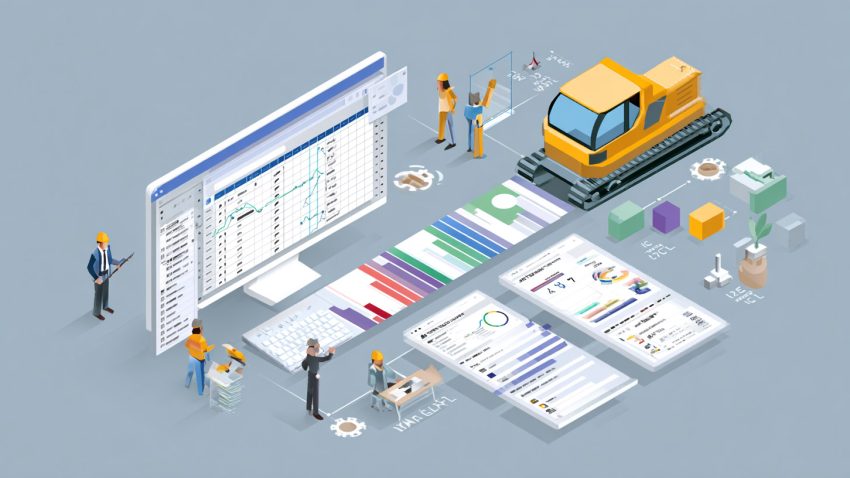The Ultimate Guide to Effective Communication in Construction: Top Useful Strategies and Tools
Table of Contents:
Dive into the ultimate guide to effective communication in construction. Discover key strategies, tools, and real-world applications that project managers can use to enhance communication, streamline workflows, and ensure successful project outcomes.

Why Effective Communication Matters in Construction
In the fast-paced world of construction, effective communication is essential. Projects involve numerous parties, including team members, stakeholders, and clients, all of whom need to be on the same page. Clear and efficient communication ensures that everyone understands their roles, responsibilities, and the project’s goals, leading to better collaboration and successful project outcomes.
The Importance of Communication
Effective communication helps prevent misunderstandings, reduces errors, and ensures that project tasks are completed on time. It fosters a collaborative environment where team members can share ideas, solve problems together, and make informed decisions. Good communication also strengthens relationships with clients and stakeholders, building trust and ensuring their satisfaction with the project.
The Consequences of Poor Communication
Poor communication can lead to numerous issues, including project delays, increased costs, and reduced quality. Misunderstandings and miscommunications can cause errors that need to be corrected, leading to rework and wasted resources. Ineffective communication can also strain relationships with clients and stakeholders, resulting in dissatisfaction and potential conflicts.
Key Strategies for Effective Construction Communication
Establishing Clear Communication Channels
Selecting the Right Tools
Choose communication tools that suit the needs of your project and team. These tools should facilitate real-time communication, document sharing, and collaboration. Examples include project management software, instant messaging apps, and video conferencing tools.
Defining Communication Protocols
Establish clear protocols for how and when communication should occur. This includes setting guidelines for meetings, reporting, and information sharing. Clear protocols ensure that everyone knows how to communicate effectively and consistently.
Enhancing Collaboration
Regular Meetings
Hold regular meetings to keep everyone informed and aligned. These meetings should include progress updates, discussions on any issues or challenges, and planning for upcoming tasks. Regular meetings ensure that everyone is on the same page and can address problems promptly.
Collaborative Platforms
Use collaborative platforms that allow team members to work together on documents, share updates, and track progress. These platforms facilitate real-time collaboration and make it easier to manage project information.
Ensuring Transparency
Open Lines of Communication
Maintain open lines of communication where team members feel comfortable sharing their ideas, concerns, and feedback. Encouraging open communication fosters a collaborative environment and helps identify issues early.
Transparent Reporting
Provide transparent and regular reporting on project progress, challenges, and changes. Transparency builds trust with clients and stakeholders and ensures that everyone is informed about the project’s status.
Essential Communication Tools for Construction
Project Management Software
Features of Project Management Software
Project management software integrates various communication functions, including task management, document sharing, and progress tracking. These tools help keep everyone aligned and streamline project communication.
Instant Messaging Apps
Benefits of Instant Messaging Apps
Instant messaging apps facilitate real-time communication among team members. They are ideal for quick updates, questions, and discussions, ensuring that information is shared promptly.
Video Conferencing Tools
Advantages of Video Conferencing Tools
Video conferencing tools enable face-to-face communication, even when team members are in different locations. These tools are essential for meetings, presentations, and collaborative discussions.
Collaborative Document Platforms
Benefits of Collaborative Document Platforms
Collaborative document platforms allow multiple users to work on the same document simultaneously. These tools are ideal for planning, design reviews, and report generation, ensuring that everyone has access to the latest information.
Best Practices for Construction Communication
Regular Updates and Meetings
Scheduled Progress Meetings
Hold scheduled progress meetings to discuss project status, upcoming tasks, and any issues. Regular meetings keep the team aligned and ensure that problems are addressed promptly.
Daily Check-ins
Implement daily check-ins to provide quick updates on tasks and progress. These brief meetings help keep everyone informed and focused on their responsibilities.
Clear and Concise Communication
Use Clear Language
Use clear and concise language in all communications to avoid misunderstandings. Ensure that instructions, updates, and feedback are easily understood by everyone involved.
Visual Aids
Use visual aids such as diagrams, charts, and plans to support verbal and written communication. Visual aids help convey complex information more effectively.
Documentation and Record-Keeping
Maintain Detailed Records
Keep detailed records of all communications, decisions, and updates. Documentation is crucial for tracking progress, resolving disputes, and providing accountability.
Use Centralized Storage
Store all project documents and communications in a centralized location accessible to all team members. Centralized storage ensures that everyone has access to the latest information.
Effective Stakeholder Communication
Regular Stakeholder Updates
Provide regular updates to stakeholders on project progress, challenges, and changes. Keeping stakeholders informed builds trust and ensures their continued support.
Tailored Communication
Tailor your communication style and content to suit the needs of different stakeholders. Ensure that the information is relevant and understandable for each audience.

Top 12 Tips for Effective Construction Communication
1. Choose the Right Communication Tools
Select tools that facilitate real-time communication, document sharing, and collaboration. Tools should be easy to use and accessible to all team members.
2. Establish Clear Protocols
Define how and when communication should occur. Clear protocols ensure consistency and effectiveness in communication.
3. Hold Regular Meetings
Schedule regular meetings to keep everyone informed and aligned. Discuss progress, challenges, and upcoming tasks.
4. Encourage Open Communication
Maintain open lines of communication where team members feel comfortable sharing ideas and concerns. Open communication fosters collaboration and early problem identification.
5. Use Visual Aids
Support verbal and written communication with visual aids like diagrams and charts. Visual aids help convey complex information more effectively.
6. Provide Transparent Reporting
Offer regular and transparent updates on project progress and changes. Transparency builds trust with clients and stakeholders.
7. Utilize Collaborative Platforms
Use platforms that allow real-time collaboration on documents and tasks. These tools streamline communication and project management.
8. Implement Daily Check-ins
Hold daily briefings to provide quick updates on tasks and progress. Daily check-ins keep everyone informed and focused.
9. Maintain Detailed Records
Document all communications, decisions, and updates. Detailed records are crucial for tracking progress and resolving disputes.
10. Store Documents Centrally
Use centralized storage for all project documents and communications. Centralized storage ensures that everyone has access to the latest information.
11. Tailor Communication for Stakeholders
Adapt your communication style and content for different stakeholders. Ensure that the information is relevant and understandable for each audience.
12. Invest in Training
Provide training on communication tools and best practices. A well-trained team is essential for effective communication and project success.

StruxHub
Discover how StruxHub can revolutionize your construction management. Contact us today!
Achieving Mastery in Construction Communication
Mastering construction communication is essential for the successful completion of any project. By leveraging advanced tools and implementing proven best practices, such as regular updates, clear protocols, and transparent reporting, you can ensure effective collaboration among team members, stakeholders, and clients.
Imagine a construction project where communication flows seamlessly, everyone is aligned, and project outcomes are consistently positive. This is the future of construction communication—a future where effective collaboration leads to project success. Let’s explore how you can make it a reality for your projects.
StruxHub enhances efficiency and coordination across all project phases, providing a single source of truth that eliminates silos and fosters collaboration. Real-time updates, financial management tools, and seamless communication features ensure that all team members and stakeholders are aligned and informed, reducing the risk of errors and delays. With comprehensive solutions for document management, risk mitigation, and quality control, StruxHub maintains project integrity and safety, while mobile access and integration capabilities further enhance project flexibility and efficiency.
StruxHub’s Key Features and Benefits:
- Advanced Delivery Management: Automate and optimize your delivery schedules, ensuring materials arrive just in time, every time.
- Site Communication: Utilize georeferenced maps and instant messaging to keep every team member informed and aligned.
- Construction Materials Management: Track inventory levels and manage materials procurement with ease, reducing waste and avoiding project delays.
- Construction Safety & Inspection Workflows: Implement customizable mobile forms for conducting safety inspections and managing compliance documentation effortlessly.
- Short-Term Scheduling: Visualize project tasks with detailed floor plans, linking each activity to specific locations for better planning accuracy.
- Construction Resource Management: Efficiently allocate personnel and equipment, maximizing productivity and reducing idle time.
StruxHub’s Product Offering:
- StruxHub Deliveries: Simplifies the coordination of incoming deliveries, ensuring materials and equipment are precisely timed to project needs.
- StruxHub Logistics: Offers intelligent site logistics planning, from crane scheduling to space allocation, for smoother operations.
- StruxHub Safety: Elevates on-site safety standards with easy-to-use tools for inspections, permits, and incident reporting.
- StruxHub Scheduling: Enhances project timelines with intuitive scheduling tools that ensure tasks are completed efficiently and on time.
With StruxHub, construction companies can look forward to a streamlined, more efficient project execution that delivers on time and within budget. Embrace the power of innovation and take your construction projects to the next level.
Don’t miss out on the opportunity to optimize your construction management processes with StruxHub. Sign up for a free demo today. Let’s build smarter, together.

StruxHub
Discover how StruxHub can revolutionize your construction management. Contact us today!
Related Articles
- The Comprehensive Guide to Effective Resource Management in Construction
- Construction Safety Management: Top 12 Ways to Boost Your Team’s Productivity
- Top 10 Best Practices for Superintendents in Construction Project Management Software
FAQ
1. What are the key components of effective communication in construction projects?
Effective communication in construction projects involves several key components. Firstly, establishing clear communication channels is crucial. This means selecting the right tools that facilitate real-time communication, document sharing, and collaboration. Examples include project management software, instant messaging apps, and video conferencing tools. Clear protocols should also be defined for how and when communication should occur, including guidelines for meetings, reporting, and information sharing.
Secondly, enhancing collaboration is essential. This involves holding regular meetings to keep everyone informed and aligned, and using collaborative platforms that allow team members to work together on documents and track progress. Regular updates and meetings ensure that the team is always on the same page and that any issues are addressed promptly.
Lastly, ensuring transparency is vital for building trust and maintaining effective communication. This includes maintaining open lines of communication where team members feel comfortable sharing ideas and concerns, and providing transparent and regular reporting on project progress and changes. Detailed documentation and record-keeping are also crucial for tracking progress and resolving disputes.

2. How can project management software improve communication in construction projects?
Project management software can significantly improve communication in construction projects by integrating various communication functions into a single platform. These tools offer features such as task management, document sharing, and progress tracking, which help keep everyone aligned and streamline project communication.
With project management software, team members can access all project-related information in one place, reducing the need for multiple communication channels and minimizing the risk of information getting lost. Real-time updates and notifications ensure that everyone is aware of the latest developments and can respond promptly to any changes or issues.
Moreover, project management software facilitates collaboration by allowing team members to work together on tasks and documents, share updates, and track progress. This helps create a transparent and collaborative environment where everyone is informed and engaged. Overall, project management software enhances efficiency, reduces misunderstandings, and supports successful project outcomes.
3. What are the benefits of using instant messaging apps for construction communication?
Instant messaging apps offer several benefits for construction communication. Firstly, they facilitate real-time communication among team members, allowing for quick updates, questions, and discussions. This ensures that information is shared promptly, reducing delays and enhancing overall efficiency.
Secondly, instant messaging apps are ideal for informal communication and quick decision-making. Team members can easily reach out to each other for immediate responses, which is particularly useful for addressing urgent issues or clarifying details on the spot.
Additionally, instant messaging apps support file sharing and multimedia messages, enabling team members to share documents, images, and videos instantly. This helps convey complex information more effectively and supports better collaboration.
Lastly, instant messaging apps often come with features like group chats, which allow for efficient communication among multiple team members. This fosters a collaborative environment where everyone can contribute to discussions and stay informed about project updates.
4. How can regular meetings improve collaboration and communication in construction projects?
Regular meetings play a crucial role in improving collaboration and communication in construction projects. Scheduled progress meetings provide an opportunity for team members to discuss the project’s status, upcoming tasks, and any issues or challenges. These meetings help ensure that everyone is informed and aligned, which is essential for coordinated efforts and successful project outcomes.
Regular meetings also foster a collaborative environment by encouraging open communication and idea sharing. Team members can discuss their concerns, provide feedback, and contribute to problem-solving, which helps address issues early and enhances overall project efficiency.
Daily check-ins are another effective way to improve communication and collaboration. These brief meetings provide quick updates on tasks and progress, helping keep everyone focused and informed. Daily check-ins also support accountability, as team members regularly report on their responsibilities and progress.
In summary, regular meetings and daily check-ins enhance communication, foster collaboration, and ensure that the project team is aligned and working towards common goals. This leads to more efficient project management and better outcomes.


